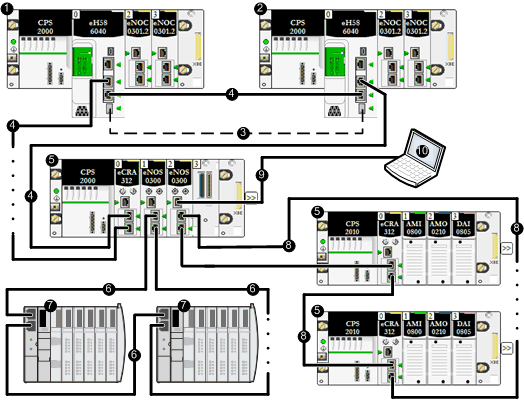RIO Sub-Ring and DIO Ring
In this topology, two BMENOS0300 network option switch modules are used in place of external dual ring switches (DRSs) to reduce cost. These modules reside in an . The ports of these modules are used as follows:
-
Two network ports of one BMENOS0300 module are configured for an RIO Ring, and support an RIO sub-ring.
-
The service port of the same module is configured as an Access port, and supports an engineering tool (for example, Control Expert) resident on a PC.
NOTE: Instead of a PC, a could be connected to the service port.
-
The two network ports of the other BMENOS0300 module are configured for a DIO Ring.
1
Primary Hot Standby PAC
2
Standby Hot Standby PAC
3
Hot Standby communication link
4
Ethernet main RIO ring
5
(e)X80 RIO drop
6
Ethernet DIO ring
7
Distributed equipment
8
Ethernet RIO sub-ring
9
Ethernet daisy chain
10
Engineering tool resident on PC
NOTE:
-
To achieve desired RSTP-based network response time targets, the longest path that an Ethernet RIO packet would have to travel in the case of a cable break is 32 switched devices, including:
-
When you set the BMENOS0300 network rotary switch to
RIO Ring, configure the RSTP bridge identifier priority settings of other devices in the RIO sub-ring to values greater than 0. Refer to the topic
Device Rotary Switch Positions for information about the effects of selecting
RIO Ring.
-
To achieve acceptable recovery times, limit the DIO design to a single DIO main ring without sub-rings.
-
When you set the BMENOS0300 network rotary switch to
DIO Ring, configure a distributed equipment Ethernet device to be the RSTP root bridge. Refer to the topic
Device Rotary Switch Positions for information about the effects of selecting
DIO Ring.
-
RSTP limits the size of the DIO ring to a maximum of 40 switched devices, including the BMENOS0300 module.
